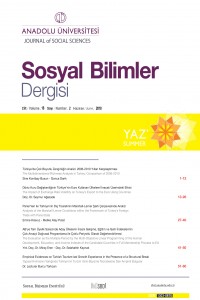Öz
Bu çalışmada 2006-2010 Gelir ve Yaşam Koşulları Araştırması verileri ile Peichl ve Pestel (2013a)’in ikili eşik değeri yöntemi kullanılarak Türkiye’de çoklu-zenginliğin gelişimi incelenmiştir. Çoklu-zenginlik, sadece tek bir zenginlik ölçütünün – en yaygın şekliyle gelir seviyesinin – dağılımına bakmak yerine, birden fazla zenginlik ölçütünü eş zamanlı göz önünde bulunduran bir kavramdır. Çalışmada, zenginlik tanımlanırken düzenli ödenen vergiler, aylık ortalama konut masrafı, menkul kıymet geliri ve menkul kıymet harici kullanılabilir gelir olmak üzere toplam dört zenginlik boyutunun ortak dağılımına bakılmış ve zengin hanehalkı, boyut ayarlamalı zenginlik ve ortalama zenginlik oranları hesaplanmıştır. Zengin hanehalkı oranının gösterdiği üzere; 2006 ve 2010 yıllarında Türkiye’deki hanehalklarının yarısından fazlası hiç bir boyutta en üst yüzde 20’lik dilime girmemektedir. Sonuçlar, ele alınan dönem içinde gelir-servet dağılımının en üst derecede zengin (dört boyutun dördünde de zengin) gurup lehine değiştiğini göstermektedir. Bulgular gelir-servet eşitsizliğine arttırıcı yönde katkı yapan menkul kıymet geliri ve verginin, bölüşüm eşitsizliğini azaltmayı hedefleyen politaka yapıcılar açısından önemini ortaya koymaktadır.
Anahtar Kelimeler
Kaynakça
- Alkire, S., Foster, J. (2011). Counting and Multidimensional Poverty Measurement. Journal of Public Economics, 95, 476–487.
- Atkinson, A. B. (2003). Multidimensional Deprivation: Contrasting Social Welfare and Counting Approaches. Journal of Economic Inequality, 1, 51–65.
- Atkinson, A. B. (2005). Comparing the Distribution of Top Incomes across Countries. Journal of the European Economic Association, 3(2-3), 393-401.
- Atkinson, A. B. ve Piketty, T. (2007). Top Incomes over the Twentieth Century. Oxford University Press, Oxford.
- Atkinson A. B., Piketty, T. ve Saez, E. (2011). Top Incomes in the Long run of History. Journal of Economic Literature, 49, 3–71.
- Boratav, K. (2015, 15 Mart). Diplomalı Proleterler: Öğretmen Olmak. www.birgun.net.
- Cowell, F. A. (2011) Inequality among the Wealthy, LSE STICERD Research Paper No. CASE150.
- Decancq, K., Lugo, M. A. (2012). Inequality of Well- Being: A Multidimensional Approach. Economica, 79 (316), 721-746.
- Decancq, K., Lugo, M. A. (2013). Weights in Multidimensional Well-Being: An Overview. Econometric Reviews, 32 (1), 7-34.
- Decancq, K, Ooghe, E. (2010). Has the World Moved Forward? A Robust Multidimensional Evaluation. Economics Letters, 107 (2), 266-269.
- Jenkins, S. P., Jantti, M. (2005). Methods for Summarizing and Comparing Wealth Distributions. ISER Working Paper 2005-05, Institute for Social and Economic Research, University of Essex, Colchester, UK.
- Kontbay-Busun, S., Peichl A. (2014). Multidimensional Affluence in Income and Wealth in the Eurozone– A Cross Country Comparison Using the HFCS. ZEW Discussion Paper 14-124.
- Kopczuk, W., Saez, E. (2004). Top Wealth Shares in the United States, 1916-2000: Evidence from Estate Tax Returns. National Tax Journal, 57(2), 445-487.
- Medeiros, M. (2006). The Rich and the Poor: the Construction of an Affluence Line from the Poverty Line. Social Indicators Research 78, 1–18.
- Peichl, A., Pestel, N. (2013a). Multidimensional Affluence: Theory and Applications to Germany and the US. Applied Economics, 45 (32), 4591-4601.
- Peichl, A., Pestel, N. (2013b). Multidimensional Wellbeing at the Top: Evidence for Germany. Fiscal Studies, 34 (3), 355-371.
- Peichl, A., Schaefer, T., Scheicher, C. (2010). Measuring Richness and Poverty: A Micro Data Application to Europe and Germany. Review of Income and Wealth, 56, 597–619.
- Piketty T. (2005). Top Income Shares in the Long Run: An Overview. Journal of the European Economic Association, 3(2-3): 382-392.
- Piketty, T., Goldhammer, A. (2014). Capital in the Twenty-first Century. Cambridge Massachusetts: Belknap of Harvard UP.
- Piketty, T., Saez, E. (2006). The Evolution of Top Incomes: A Historical and International Perspective. American Economic Review, 96 (2), 200-205.
- Roine, J., Vlachos, J., Waldenström, D. (2009). The Long-run Determinants of Inequality: What Can We Learn from Top Income Data?. Journal of Public Economics, 93 (7-8), 974-988.
- Roine, J., Waldenstrom, D. (2008). The Evolution of Top Incomes in an Egalitarian Society: Sweden, 1903-2004. Journal of Public Economics, 92 (1-2), 366-387.
- Roine J., Waldenström, D. (2011). Common Trends and Shocks to Top Incomes: A Structural Breaks Approach. The Review of Economics and Statistics, 93 (3), 832-846.
- Saez E. (2005). Top Incomes in the United States and Canada Over the Twentieth Century,“ Journal of the European Economic Association, 3 (2-3), 402-411.
- Sönmez, M. (2014, 13 Ekim). Turkey Ranks First in the Inequality of Income Distribution. www.hurriyetdailynews.com.
- Stiglitz J. E., Sen A., Fitoussi J. P. (2009). Report by the Commission on the Measurement of Economic Performance and Social Progress. Paris.
Ayrıntılar
| Birincil Dil | Türkçe |
|---|---|
| Bölüm | Makaleler |
| Yazarlar | |
| Yayımlanma Tarihi | 20 Haziran 2018 |
| Gönderilme Tarihi | 24 Nisan 2016 |
| Yayımlandığı Sayı | Yıl 2018 Cilt: 18 Sayı: 2 |
Bu eser Creative Commons Atıf-GayriTicari 4.0 Uluslararası Lisansı ile lisanslanmıştır.


